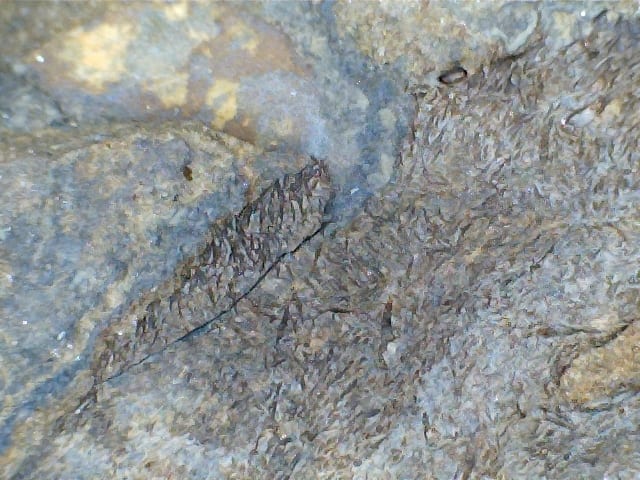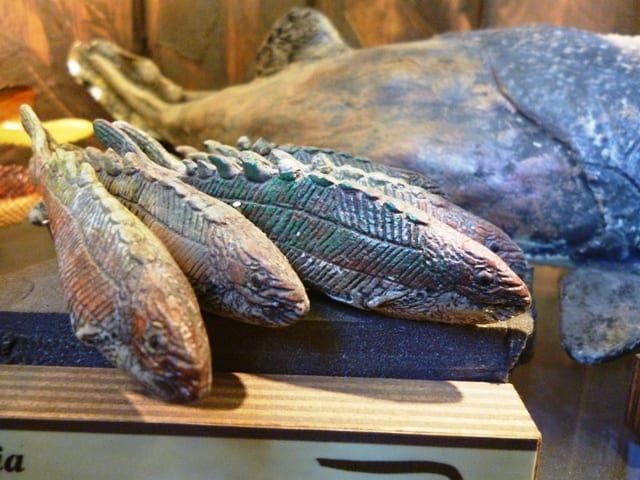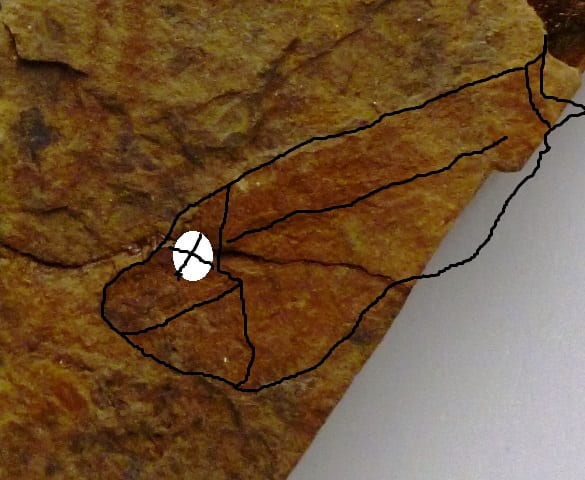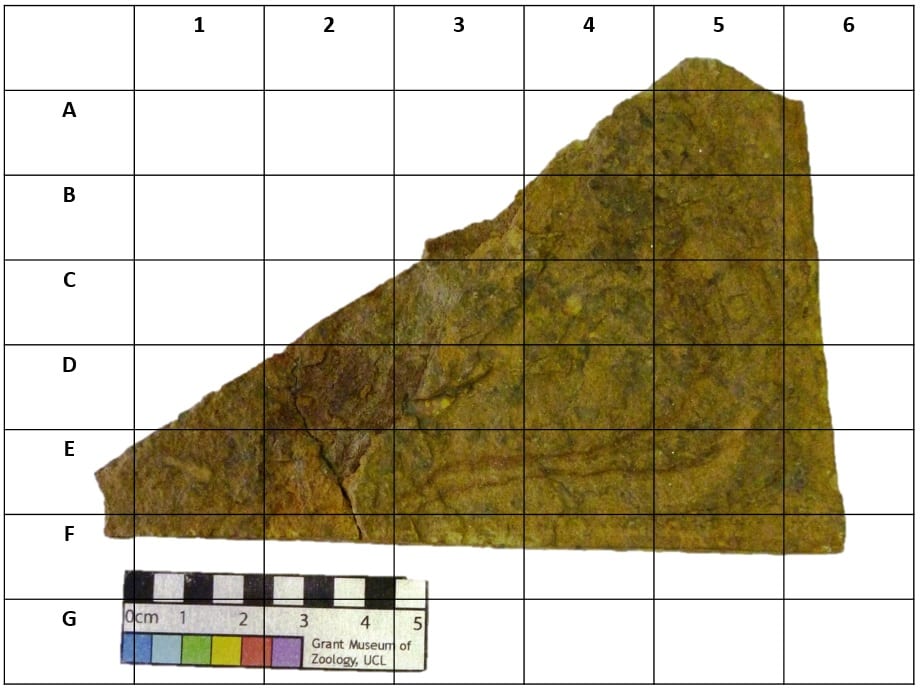Underwhelming Fossil Fish of the Month: February 2015
By Mark Carnall, on 27 February 2015
Welcome one, welcome all to February 2015’s Underwhelming Fossil Fish of the Month. For the uninitiated, this blog series is an exploration of world of underwhelming fossil fish. Natural history museums are packed with millions of specimens but most aren’t the celebrated, charismatic, blockbusting Hollywood specimens. Most are uncelebratable data points. Broken, ugly and altogether uninteresting. This series, the whole of which you can browse through here (READER DISCRETION ADVISED: reading too many in one sitting may put you in a permanent state of torpor), focuses on the Grant Museum’s fossil fish collection. Month by month we swivel the spotlight onto one of our fossil fish specimens and contemplate the borderline mediocre. Why do we have these specimens? Can we learn something about ourselves by trying to stay awake reading about them? No. No of course we can’t.
Matchstick props to keep your eyes open recommended for this one, set phasers to underwhelm. For series fans you may be slightly excited to learn it’s a return of the SPOT THE FOSSIL FISH format that nobody has been clamouring for!
My usual ritual for finding an underwhelming fossil fish is to go to one of our fossil fish drawers and within about two minutes in the first drawer I’ll find something that’s perfectly underwhelming. This month, I found this beauty whilst fixing our fossil drawer units and what instantly caught my eye is the apparent absence of anything resembling a fossil fish. Have a butchers at the grid below can you find a fossil fish? Hint- it”s not in F-Zero (show me your moves).
Did you find it? I’m impressed if you did because I’m not 100% sure where it is. Don’t be fooled by the deceptively fish-shaped iron banding that starts in E2 and ends in B5, that’s a result of weathering and sedimentation. I’ve combed over this specimen and it’s counter part with my constantly disappointing but affordable USB microscope and there’s a bit of brown in D2 which looks less like not a fossil fish than the rest of the slab. Here’s what it looks like once the USB microscope has converted it into an impressionist painting.

Impressionist interpretation of LDUCZ-V797 created by the low resolution of the perpetually disappointing but affordably cheap USB microscope.
Remarkably, this ‘fossil’ has been identified as Silurian species Birkenia elegans. In isolation there’s no way that we can confirm this identification. I suspect, as with other fragmentary fossils I’ve featured which have been suspiciously identified to species level, this was an example of many specimens excavated at the same time so anything ‘bony’ looking of a certain size was lumped as fish species X or Y already known from the site. From our old fossil catalogue, this fossil is indeed one of a series of fossils collected from the Slot Burn Formation near Muirkirk in East Ayrshire, Scotland. Even though we don’t have enough here to confidently identify it to species level I’m going to stick with the given identity for the purposes of this blog. Birkenia elegans is a species of anaspid fish, jawless fish who lack the bony head shield found in other early jawless fish, known from Northern Europe. If you’re a regular Grant Museum visitor the name may ring some bells and that’s because we have a lovely little school of plaster Birkenia models in our appropriately named fossil fish models case.

Meet Pugh, Pugh, Barney McGrew, Cuthbert and Dibble. AKA LDUCZ-V1069 Models of Birkenia on display in the Grant Museum. I’ve seen these models at a number of natural history museums as part of a set of Devonian and Silurian plaster fish models but surprisingly, nobody seems to know who made them and when. If you have any information, please pop it in the comments.
Preservation The preservation of this specimen has been described by one palaeontologist as “pants” and “not very good”. Fossils from this locality often represent organic remains that had partially decomposed and what we have here at best is a selection of scales. From a distance, if you squint hard enough, know what you’re looking for and click your heels three times at the counterpart for this specimen you could be tempted to think that a median line, possibly the preserved spine and a slight orientation of the scales can be discerned. With the aid of Microsoft paint modern computer wizadry, an up and coming talented palaeo-artist available for commissions has come up with this interpretation:

Highly skilled reconstruction from counterpart of LDUCZ-V797 showing extremely clearly what this fish may have looked like without a shadow of doubt or any confusion at all.
Research When Birkenia was first described in 1898 it was assumed that anaspid fishes had heterocercal tails (with a long top lobe of the tail fins) not hypocercal tails (with a long bottom lobe of the tail fins) so for over 20 years, Birkenia was reconstructed upside down with apparently no comment on the mouth and eyes being the wrong way around (Traquair 1898). This was corrected in 1924 after the discovery of much better preserved anaspid fossils from Norway (Kiaer 1924). From a quick scan of the wider literature, Birkenia is often mentioned in the same breadth as being notable for a lack of anatomical features even in beautifully preserved specimens and I quote “In fact, beautifully preserved specimens of well-known taxa such as Birkenia and Rhyncholepis, respectively from the Silurian of Scotland and Norway, yield very few anatomical details” (Blom 2005). The main interest in Birkenia has been in passing through reflections of the anatomy of the gill openings in the study of the timing of the evolution of jaws.
In Society You won’t be surprised to find that Birkenia seems to have had little impact in wider society. A telltale sign that this is the case is when images of the Grant Museum models and dictionary links appear on the first page of speculative Google searches to find some evidence of a broader cultural impact. Amongst the slimmest of pickings it appears that at least one person has made a Birkenia themed calendar although my Japanese isn’t up to scratch so I have no idea what’s actually going on on this webpage.
Birkenia elegans
Preservation 0.5
Research 3
In Society 0.1
Underwhelmingness 9
References
Blom, H. 2005.Interrelationships and evolutionary history of anaspid fishes. Abstracts of Papers: Sixty-Fifth Annual Meeting Society of Vertebrate Paleontology Mesa Southwest Museum and Phoenix Marriott Mesa Mesa, Arizona October 19-22,2005. Journal of Vertebrate Paleontology. Vol. 25, No. 3, Supplement. Abstracts of Papers. Sixty-Fifth Annual Meeting, Society of Vertebrate Paleontology (Sep. 7, 2005).
Kiaer, J. 1924 The Downtonian fauna of Norway, 1. Anaspida. Norske Vidensk Academien Skrifter, 6, 1–139.
Traquair, R.H. 1898. Notes on Palaeozoic fishes, II. Annals and Magazine of Natural History 7, Series II, 67–70.
Mark Carnall is the Curator of the Grant Museum of Zoology
4 Responses to “Underwhelming Fossil Fish of the Month: February 2015”
- 1
-
2
Underwhelming Fossil Fish of the Month: July 2015 | UCL Museums & Collections Blog wrote on 31 July 2015:

[…] underwhelming fossil fish I’ve featured here that could have really done with it (examples here and here) someone has helpfully scratched/drawn around the fossil just in case you couldn’t […]
-
3
Underwhelming Fossil Fish of the Month: December 2015 | UCL Museums & Collections Blog wrote on 21 January 2016:

[…] year started off on an uncharacteristic handsome note and the much celebrated return of SPOT THE FOSSIL FISH for February. March was meh. April was all spikes and no trousers. May saw the series’ first […]
-
4
Underwhelming Fossil Fish of the Month: February 2016 | UCL Museums & Collections Blog wrote on 26 February 2016:

[…] is a bit of an enigma which we’ll come on to. Lasanius problematicus is closely related to Birkenia which have also been featured here, which puts the anaspids in contention for the most underwhelming class of fish of all time based […]
 Close
Close



[…] last month’s deeply underwhelming fossil fish of the month the head of the network has been in touch to ask if I can sex it up a bit for everyone’s […]